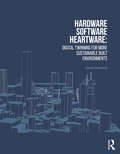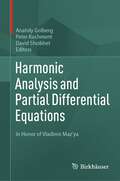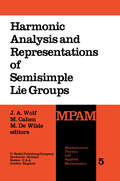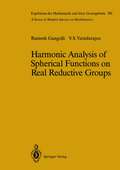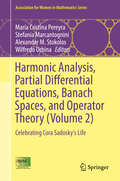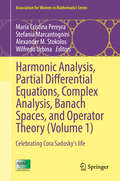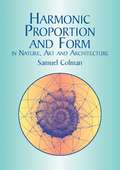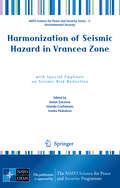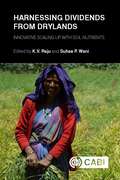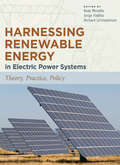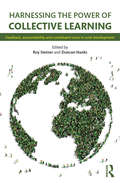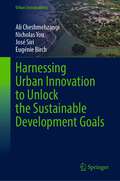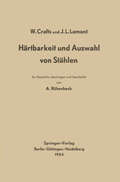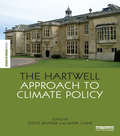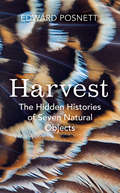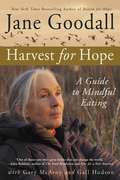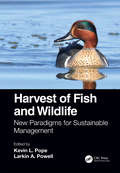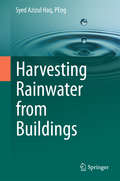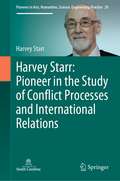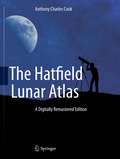- Table View
- List View
Hardware, Software, Heartware: Digital Twinning for More Sustainable Built Environments
by Jason PomeroyThis richly illustrated book examines the full potential of Digital Twins (DTs) as a means of creating more sustainable urban habitats. It reveals how, in this digitally-enabled age, DTs are increasingly being adopted by cities as a tool for urban governance, with the hope of increasing operational efficiencies and enhancing citizens’ lives.While the study and implementation of DTs has been critically explored as virtual, dynamic 3D replicas of physical entities across different disciplines and industries, this book establishes a strategy that recognises the need for the ‘software’ behind virtual DT platforms to not only represent the ‘hardware’ of our physical cities but also to reflect the ‘heartware’ of socio-economic and cultural practices. Knowledge gaps and challenges in existing DTs are identified and insights into rethinking their purpose are provided to propose a new DT paradigm model for city-wide application. With multiple case studies illustrating the different concepts of DTs being applied in cities from Europe, North America, The Middle East, Asia and Oceania, the book highlights the reasons why and how DTs can play an integral role in the sustainability of our urban habitats.Beautifully designed and illustrated in full colour throughout, this book combines academic theory with practical application and will be a useful reference for professionals, students, academics and policymakers, working in the fields of smart cities, sustainable urbanism, and the digitisation, digitalisation and digital transformation of the built environment industry.
Hardware, Software, Heartware: Digital Twinning for More Sustainable Built Environments
by Jason PomeroyThis richly illustrated book examines the full potential of Digital Twins (DTs) as a means of creating more sustainable urban habitats. It reveals how, in this digitally-enabled age, DTs are increasingly being adopted by cities as a tool for urban governance, with the hope of increasing operational efficiencies and enhancing citizens’ lives.While the study and implementation of DTs has been critically explored as virtual, dynamic 3D replicas of physical entities across different disciplines and industries, this book establishes a strategy that recognises the need for the ‘software’ behind virtual DT platforms to not only represent the ‘hardware’ of our physical cities but also to reflect the ‘heartware’ of socio-economic and cultural practices. Knowledge gaps and challenges in existing DTs are identified and insights into rethinking their purpose are provided to propose a new DT paradigm model for city-wide application. With multiple case studies illustrating the different concepts of DTs being applied in cities from Europe, North America, The Middle East, Asia and Oceania, the book highlights the reasons why and how DTs can play an integral role in the sustainability of our urban habitats.Beautifully designed and illustrated in full colour throughout, this book combines academic theory with practical application and will be a useful reference for professionals, students, academics and policymakers, working in the fields of smart cities, sustainable urbanism, and the digitisation, digitalisation and digital transformation of the built environment industry.
Harmonic Analysis and Partial Differential Equations: In Honor of Vladimir Maz'ya
Over the course of his distinguished career, Vladimir Maz'ya has made a number of groundbreaking contributions to numerous areas of mathematics, including partial differential equations, function theory, and harmonic analysis. The chapters in this volume - compiled on the occasion of his 80th birthday - are written by distinguished mathematicians and pay tribute to his many significant and lasting achievements.
Harmonic Analysis and Representations of Semisimple Lie Groups: Lectures given at the NATO Advanced Study Institute on Representations of Lie Groups and Harmonic Analysis, held at Liège, Belgium, September 5–17, 1977 (Mathematical Physics and Applied Mathematics #5)
by J. A. Wolf M. Cahen M. De WildeThis book presents the text of the lectures which were given at the NATO Advanced Study Institute on Representations of Lie groups and Harmonic Analysis which was held in Liege from September 5 to September 17, 1977. The general aim of this Summer School was to give a coordinated intro duction to the theory of representations of semisimple Lie groups and to non-commutative harmonic analysis on these groups, together with some glance at physical applications and at the related subject of random walks. As will appear to the reader, the order of the papers - which follows relatively closely the order of the lectures which were actually give- follows a logical pattern. The two first papers are introductory: the one by R. Blattner describes in a very progressive way a path going from standard Fourier analysis on IR" to non-commutative harmonic analysis on a locally compact group; the paper by J. Wolf describes the structure of semisimple Lie groups, the finite-dimensional representations of these groups and introduces basic facts about infinite-dimensional unitary representations. Two of the editors want to thank particularly these two lecturers who were very careful to pave the way for the later lectures. Both these chapters give also very useful guidelines to the relevant literature.
Harmonic Analysis of Spherical Functions on Real Reductive Groups (Ergebnisse der Mathematik und ihrer Grenzgebiete. 2. Folge #101)
by Ramesh Gangolli Veeravalli S. VaradarajanAnalysis on Symmetric spaces, or more generally, on homogeneous spaces of semisimple Lie groups, is a subject that has undergone a vigorous development in recent years, and has become a central part of contemporary mathematics. This is only to be expected, since homogeneous spaces and group representations arise naturally in diverse contexts ranging from Number theory and Geometry to Particle Physics and Polymer Chemistry. Its explosive growth sometimes makes it difficult to realize that it is actually relatively young as mathematical theories go. The early ideas in the subject (as is the case with many others) go back to Elie Cart an and Hermann Weyl who studied the compact symmetric spaces in the 1930's. However its full development did not begin until the 1950's when Gel'fand and Harish Chandra dared to dream of a theory of representations that included all semisimple Lie groups. Harish-Chandra's theory of spherical functions was essentially complete in the late 1950's, and was to prove to be the forerunner of his monumental work on harmonic analysis on reductive groups that has inspired a whole generation of mathematicians. It is the harmonic analysis of spherical functions on symmetric spaces, that is at the focus of this book. The fundamental questions of harmonic analysis on symmetric spaces involve an interplay of the geometric, analytical, and algebraic aspects of these spaces. They have therefore attracted a great deal of attention, and there have been many excellent expositions of the themes that are characteristic of this subject.
Harmonic Analysis, Partial Differential Equations, Banach Spaces, and Operator Theory: Celebrating Cora Sadosky's Life (Association for Women in Mathematics Series #5)
by María Cristina Pereyra Stefania Marcantognini Alexander M. Stokolos Wilfredo UrbinaThis book is the second of a two volume series. Covering a range of subjects from operator theory and classical harmonic analysis to Banach space theory, this book features fully-refereed, high-quality papers exploring new results and trends in weighted norm inequalities, Schur-Agler class functions, complex analysis, dynamical systems, and dyadic harmonic analysis. Graduate students and researchers in analysis will find inspiration in the articles collected in this volume, which emphasize the remarkable connections between harmonic analysis and operator theory. A survey of the two weight problem for the Hilbert transform and an expository article on the Clark model to the case of non-singular measures and applications to the study of rank-one perturbations are included. The material for this volume is based on the 13th New Mexico Analysis Seminar held at the University of New Mexico, April 3-4, 2014 and on several special sections of the Western Spring Sectional Meeting at the University of New Mexico, April 4-6,2014. During the event, participants honored the memory of Cora Sadosky—a great mathematician who recently passed away and who made significant contributions to the field of harmonic analysis. Cora was an exceptional scientist and human being. She was a world expert in harmonic analysis and operator theory, publishing over fifty-five research papers and authoring a major textbook in the field. Participants of the conference include new and senior researchers, recent doctorates as well as leading experts in the area.
Harmonic Analysis, Partial Differential Equations, Complex Analysis, Banach Spaces, and Operator Theory: Celebrating Cora Sadosky's life (Association for Women in Mathematics Series #4)
by María Cristina Pereyra Stefania Marcantognini Alexander M. Stokolos Wilfredo UrbinaCovering a range of subjects from operator theory and classical harmonic analysis to Banach space theory, this book contains survey and expository articles by leading experts in their corresponding fields, and features fully-refereed, high-quality papers exploring new results and trends in spectral theory, mathematical physics, geometric function theory, and partial differential equations. Graduate students and researchers in analysis will find inspiration in the articles collected in this volume, which emphasize the remarkable connections between harmonic analysis and operator theory. Another shared research interest of the contributors of this volume lies in the area of applied harmonic analysis, where a new notion called chromatic derivatives has recently been introduced in communication engineering. The material for this volume is based on the 13th New Mexico Analysis Seminar held at the University of New Mexico, April 3-4, 2014 and on several special sections of the Western Spring Sectional Meeting at the University of New Mexico, April 4-6, 2014. During the event, participants honored the memory of Cora Sadosky—a great mathematician who recently passed away and who made significant contributions to the field of harmonic analysis. Cora was an exceptional mathematician and human being. She was a world expert in harmonic analysis and operator theory, publishing over fifty-five research papers and authoring a major textbook in the field. Participants of the conference include new and senior researchers, recent doctorates as well as leading experts in the area.
Harmonic Proportion and Form in Nature, Art and Architecture (General Science)
by Samuel ColmanA treatise on the laws governing proportional form in both nature and the arts and sciences, this well-illustrated volume amply demonstrates how a design's geometrical construction can captivate both the eye and the mind. Flowers, shells, and other natural organisms appear here, along with artistic creations, in a mathematical study of the similarity of their constructive principles. These principles, in turn, are the fundamental elements by which nature creates harmony.The author, Samuel Colman (1832–1920), was a prominent member of the Hudson River School of painters ("Storm King on the Hudson," his 1866 oil on canvas, is one of his best-known works), and an embodiment through his life and work of the school's celebration of nature through art. As an activist in the politics of art, Colman helped form the Society of American Artists as well as the American Society of Painters in Water Colors, a relatively new medium at the time. He was also a teacher and associate of Louis Comfort Tiffany; in 1879, the two joined forces to establish an interior design firm that included Mark Twain among its clientele.This handsome and provocative volume is enhanced by 302 drawings by the author that complement and amplify each subject area discussed. It also includes an important Mathematical Analysis by the editor, C. Arthur Coan. As a multifaceted study, this book will find an audience among artists and philosophers, as well as scientists and mathematicians.
Harmonization of Seismic Hazard in Vrancea Zone: with Special Emphasis on Seismic Risk Reduction (NATO Science for Peace and Security Series C: Environmental Security)
by Anton Zaicenco Iolanda Craifaleanu Ivanka PaskalevaThe NATO Science for Peace Project SfP-980468 Harmonization of Seismic Hazard and Risk Reduction in Countries Influenced by Vrancea Earthquakes was an ambitious attempt to harmonize the seismic-hazard assessment in Bulgaria, Moldova and Romania, and provide the guidelines for seismic risk reduction in the target countries. Related to the study of intermediate-depth Vrancea earthquakes, it became operational in 2005. The project co-coordinators were as follows: • Prof. Güney Özcebe, Ankara, Turkey; • Dr. Anton Zaicenco, Chisinau, Moldova; • Dr. Iolanda Craifaleanu, Bucharest, Romania; • Prof. Ivanka Paskaleva, Sofia, Bulgaria. The project has brought together leading research personalities in the area of earthquake engineering, seismology and earth physics from several countries for brainstorming sessions, informal discussions, and exchanges of ideas. One of its key components was an upgrade of the strong-motion seismic networks of the countries-participants, which created a foundation for a long-term collaboration. A number of papers have been published as a result of the work conducted under this project. The present book contains the Proceedings of the Closing Workshop for Project SfP-980468, which was organized in Chisinau, Moldova on May 20, 2008. From hazard analyses to protection of the historical buildings, from study of the dynamic properties of the soft soils to paleoseismology, there are few areas of interest that remain untouched. Research from the NATO members and partner countries in South-Eastern Europe that forms the components of NATO Project SfP-980468 has made solid contributions to the Workshop theme.
Harnessing Dividends from Drylands: Innovative Scaling up with Soil Nutrients
by Kanwar Sahrawat Girish Chander G. Pardhasaradhi K. Krishnappa K. H. Anantha Gajanan Sawargaonkar Mukund Patil V. Nageswara Rao A.V.R. Kesava Rao K Srinivas Raghavendra Sudi Kaushal GargThe livelihoods of millions of people in developing countries, which depend on dryland agriculture to ensure their food security and their well-being, could be improved measurably by gains in agricultural crop yields. This book describes lessons learnt from an innovative scheme in India that improved crop yields in drylands. It shows how the scheme can be scaled up for other dryland regions of the world. The scheme uses localized soil nutrient analyses to create an integrated, climate smart fertilizer and planting plan that maximises yields for farmers. This book describes how a partnership between a global scientific organization (such as International Crops Research Institute for the Semi-Arid Tropics, ICRISAT) and state and non-state actors can provide a route to equitable growth, specifically for small and marginal farmers, and how this approach can be replicated worldwide to enhance rural livelihoods. This strategic collaboration and its conceptual and functional design is fully outlined, as well as the scheme's implementation and the effective monitoring and learning process that has been created.
Harnessing Renewable Energy in Electric Power Systems: Theory, Practice, Policy
by Boaz Moselle Jorge Padilla Richard SchmalenseeReflecting its reliance on fossil fuels, the electric power industry produces the majority of the world's greenhouse gas emissions. The need for a revolution in the industry becomes further apparent given that 'decarbonization' means an increasing electrification of other sectors of the economy�in particular, through a switch from gasoline to electric vehicles. Of the options for producing electric power without significant greenhouse gas emissions, renewable energy is most attractive to policymakers, as it promises increased national self-reliance on energy supplies and the creation of new industries and jobs, without the safety and political concerns of nuclear power or the unproven technology of carbon capture and storage. Drawing on both economic theory and the experiences of the United States and EU member states, Harnessing Renewable Energy addresses the key questions surrounding renewable energy policies. How appropriate is the focus on renewable power as a primary tool for reducing greenhouse gas emissions? If renewable energy is given specific support, what form should that support take? What are the implications for power markets if renewable generation is widely adopted? Thorough and well-evidenced, this book will be of interest to a broad range of policymakers, the electric power industry, and economists who study energy and environmental issues.
Harnessing Renewable Energy in Electric Power Systems: Theory, Practice, Policy
by Boaz Moselle Jorge Padilla Richard SchmalenseeReflecting its reliance on fossil fuels, the electric power industry produces the majority of the world's greenhouse gas emissions. The need for a revolution in the industry becomes further apparent given that 'decarbonization' means an increasing electrification of other sectors of the economy�in particular, through a switch from gasoline to electric vehicles. Of the options for producing electric power without significant greenhouse gas emissions, renewable energy is most attractive to policymakers, as it promises increased national self-reliance on energy supplies and the creation of new industries and jobs, without the safety and political concerns of nuclear power or the unproven technology of carbon capture and storage. Drawing on both economic theory and the experiences of the United States and EU member states, Harnessing Renewable Energy addresses the key questions surrounding renewable energy policies. How appropriate is the focus on renewable power as a primary tool for reducing greenhouse gas emissions? If renewable energy is given specific support, what form should that support take? What are the implications for power markets if renewable generation is widely adopted? Thorough and well-evidenced, this book will be of interest to a broad range of policymakers, the electric power industry, and economists who study energy and environmental issues.
Harnessing the Power of Collective Learning: Feedback, accountability and constituent voice in rural development
by Roy Steiner Duncan HanksWhat were new ideas 30 years ago, such as the concepts of participatory development and systems thinking, are now accepted norms in international development circles. The majority of professionals engaged in rural development accept the proposition that the people who participate in development should play an active role in defining, implementing, and evaluating projects intended to improve their productivity and lives. However this goal remains unrealized in many development programs. Harnessing the Power of Collective Learning considers the challenges and potential of enabling collective learning in rural development initiatives. The book presents 11 case studies of organizations trying to develop and implement collective learning systems as an integral component of sustainable development practice. Through systematic reflection on action and experience, key lessons and themes emerge regarding the nature of voice, participation, feedback loops, accountability and transparency, that will be useful for many others in the development community. This book is a useful resource for academics, practitioners and policy makers in the areas of international development, sustainable development, organizational development, philanthropy, learning communities, monitoring and evaluation and rural development.
Harnessing the Power of Collective Learning: Feedback, accountability and constituent voice in rural development
by Roy Steiner Duncan HanksWhat were new ideas 30 years ago, such as the concepts of participatory development and systems thinking, are now accepted norms in international development circles. The majority of professionals engaged in rural development accept the proposition that the people who participate in development should play an active role in defining, implementing, and evaluating projects intended to improve their productivity and lives. However this goal remains unrealized in many development programs. Harnessing the Power of Collective Learning considers the challenges and potential of enabling collective learning in rural development initiatives. The book presents 11 case studies of organizations trying to develop and implement collective learning systems as an integral component of sustainable development practice. Through systematic reflection on action and experience, key lessons and themes emerge regarding the nature of voice, participation, feedback loops, accountability and transparency, that will be useful for many others in the development community. This book is a useful resource for academics, practitioners and policy makers in the areas of international development, sustainable development, organizational development, philanthropy, learning communities, monitoring and evaluation and rural development.
Harnessing Urban Innovation to Unlock the Sustainable Development Goals (Urban Sustainability)
by Ali Cheshmehzangi Nicholas You José Siri Eugénie BirchThis book first attempts to explore the nexus between urban innovation and sustainable development goals (SDGs). It puts together global examples of urban innovation initiatives, highlighting practical, policy-oriented, social, and technological interventions. The case studies are divided into four clusters of ‘green cities’, ‘inclusive cities’, ‘resilient cities’, and ‘healthy cities’. In doing so, the book maps various global examples of urban innovation for sustainable pathways and directions. It also highlights means of implementation of tool and technologies, data, financing, and governance. The overarching aim is to provide a holistic overview of urban innovation sustainable development nexus, which would help future policy development, paradigm shifts, and technological applications.By summarising a selection of successful initiatives, interventions, and projects, this book highlights how urban innovation could accelerate achieving SDGs. The lessons learned from each case study cluster are narrated as knowledge transfer platforms for future city development and achieving sustainable development. These lessons will be beneficial to practitioners and governments, as well as researchers and academics who are interested in urban innovation research. City case studies included in the book are based on their success stories as role models for other cities in developed and developing nations. This collection helps us portray a more holistic image of urban innovation aligned with the SDGs and pathways to achieving them.
The Hartwell Approach to Climate Policy (The Earthscan Science in Society Series)
by Steve Rayner Mark CaineThe Hartwell Approach to Climate Policy presents a powerful critique of mainstream climate change policies and details a set of pragmatic alternatives based on the Hartwell Group’s collective writings from 1988-2010. Drawing on a rich history of heterodox but increasingly accepted views on climate change policy, this book brings together in a single volume a series of key, related texts that define the ‘Hartwell critique’ of conventional climate change policies and the ‘Hartwell approach’ to building more inclusive, pragmatic alternatives. This book tells of the story of how and why conventional climate policy has failed and, drawing from lessons learned, how it can be renovated. It does so by weaving together three strands of analysis. First, it highlights why the mainstream approach, as embodied by the Kyoto Protocol, has failed to produce real world reductions in greenhouse gas emissions and delayed real meaningful progress on climate change. Second, it explores the underlying political, economic, and technological factors which form the boundary conditions for climate change policy but which are often ignored by policy makers and advocates. Finally, it lays out a novel approach to climate change guided centrally by the goal of uplifting human dignity worldwide—and the recognition that this can only succeed if pursued pragmatically, economically, and with democratic legitimacy. With contributions from leading scholars in the field, this work presents a original critique of climate policy and a constructive primer for how to improve it.
The Hartwell Approach to Climate Policy (The Earthscan Science in Society Series)
by Steve Rayner Mark CaineThe Hartwell Approach to Climate Policy presents a powerful critique of mainstream climate change policies and details a set of pragmatic alternatives based on the Hartwell Group’s collective writings from 1988-2010. Drawing on a rich history of heterodox but increasingly accepted views on climate change policy, this book brings together in a single volume a series of key, related texts that define the ‘Hartwell critique’ of conventional climate change policies and the ‘Hartwell approach’ to building more inclusive, pragmatic alternatives. This book tells of the story of how and why conventional climate policy has failed and, drawing from lessons learned, how it can be renovated. It does so by weaving together three strands of analysis. First, it highlights why the mainstream approach, as embodied by the Kyoto Protocol, has failed to produce real world reductions in greenhouse gas emissions and delayed real meaningful progress on climate change. Second, it explores the underlying political, economic, and technological factors which form the boundary conditions for climate change policy but which are often ignored by policy makers and advocates. Finally, it lays out a novel approach to climate change guided centrally by the goal of uplifting human dignity worldwide—and the recognition that this can only succeed if pursued pragmatically, economically, and with democratic legitimacy. With contributions from leading scholars in the field, this work presents a original critique of climate policy and a constructive primer for how to improve it.
Harvest: The Hidden Histories of Seven Natural Objects
by Edward Posnett‘An exceptional first book; Harvest is a subtle, fascinating braiding of travel, cultural and natural history … It is a pleasure and an education to journey with him in these pages’ Robert MacfarlaneIn a centuries-old tradition, farmers in northwestern Iceland scour remote coastal plains for the down of nesting eider ducks.High inside a vast cave in Borneo, men perched atop rickety ladders collect swiftlets’ nests, a delicacy believed to be a cure for almost anything.Eiderdown and edible birds’ nests: both are luxury products, ultimately destined for the super-rich. To the rest of the world these materials are mere commodities but to the harvesters they are all imbued with myth, tradition, folklore and ritual, and form part of a shared identity and history.These objects are two of the seven natural wonders whose stories Harvest tells: eiderdown, vicuña wool, sea silk, vegetable ivory, civet coffee, guano and edible birds’ nests. Harvest follows their journey from the wildest parts of the planet, traversing Iceland, Indonesia, and Peru, to its urban centres, drawing on the voices of the gatherers, shearers and entrepreneurs who harvest, process and trade them.Blending interviews, history and travel writing, Harvest sets these human stories against our changing economic and ecological landscape. What do they tell us about capitalism, global market forces and overharvesting? How does a local micro-economy survive in a hyper-connected world?Harvest makes us see the world with wonder, curiosity and new concern. It is an original and magical new map of our world and its riches.
Harvest for Hope: A Guide to Mindful Eating
by Jane Goodall Gail Hudson Gary McAvoyFrom world-renowned scientist Jane Goodall, as seen in the new National Geographic documentary Jane, comes a provocative look into the ways we can positively impact the world by changing our eating habits. "One of those rare, truly great books that can change the world." - John Robbins, author of The Food RevolutionThe renowned scientist who fundamentally changed the way we view primates and our relationship with the animal kingdom now turns her attention to an incredibly important and deeply personal issue-taking a stand for a more sustainable world. In this provocative and encouraging book, Jane Goodall sounds a clarion call to Western society, urging us to take a hard look at the food we produce and consume-and showing us how easy it is to create positive change.Offering her hopeful, but stirring vision, Goodall argues convincingly that each individual can make a difference. She offers simple strategies each of us can employ to foster a sustainable society. Brilliant, empowering, and irrepressibly optimistic, HARVEST FOR HOPE is one of the most crucial works of our age. If we follow Goodall's sound advice, we just might save ourselves before it's too late.
Harvest of Fish and Wildlife: New Paradigms for Sustainable Management
by Kevin L. PopeHarvest of Fish and Wildlife: New Paradigms for Sustainable Management unites experts in wildlife and fishery sciences for an interdisciplinary overview of harvest management. This book presents unique insights for embracing the complete social-ecological system to ensure a sustainable future. It educates users on evolutionary and population dynamics; social and political influences; hunter and angler behavior; decision processes; impacts of regulations; and stakeholder involvement. Features: Written by twenty-four teams of leading scientists and managers. Promotes transparent justification for fishing and hunting regulations. Provides examples for integrating decision making into management. Emphasizes creativity in management by integrating art and science. This book appeals to population biologists, evolutionary biologists and social scientists. It is a key resource for on-the-ground managers and research scientists developing harvesting applications. As the book’s contributors explain: “Making decisions that are robust to uncertainty…is a paradigm shift with a lot of potential to improve outcomes for fish and wildlife populations.” –Andrew Tyre and Brigitte Tenhumberg “Temporal shifts in system states…must somehow be anticipated and dealt with to derive harvest policies that remain optimal in the long term.” –Michael Conroy “Proactive, effective management of sportspersons…will be essential in the new paradigm of harvest management.” –Matthew Gruntorad and Christopher Chizinski
Harvest of Fish and Wildlife: New Paradigms for Sustainable Management
by Kevin L. Pope Larkin A. PowellHarvest of Fish and Wildlife: New Paradigms for Sustainable Management unites experts in wildlife and fishery sciences for an interdisciplinary overview of harvest management. This book presents unique insights for embracing the complete social-ecological system to ensure a sustainable future. It educates users on evolutionary and population dynamics; social and political influences; hunter and angler behavior; decision processes; impacts of regulations; and stakeholder involvement. Features: Written by twenty-four teams of leading scientists and managers. Promotes transparent justification for fishing and hunting regulations. Provides examples for integrating decision making into management. Emphasizes creativity in management by integrating art and science. This book appeals to population biologists, evolutionary biologists and social scientists. It is a key resource for on-the-ground managers and research scientists developing harvesting applications. As the book’s contributors explain: “Making decisions that are robust to uncertainty…is a paradigm shift with a lot of potential to improve outcomes for fish and wildlife populations.” –Andrew Tyre and Brigitte Tenhumberg “Temporal shifts in system states…must somehow be anticipated and dealt with to derive harvest policies that remain optimal in the long term.” –Michael Conroy “Proactive, effective management of sportspersons…will be essential in the new paradigm of harvest management.” –Matthew Gruntorad and Christopher Chizinski
Harvesting Rainwater from Buildings
by Syed Azizul Haq, PEngThe present book describes in detail all aspects of rainwater harvesting, including the basic concepts, procedures, opportunities and practice of rainwater harvesting mainly focusing its application in buildings of various occupancies and sizes. It provides a user-friendly methodology for the planning, design, construction and maintenance of rainwater harvesting infrastructure, in buildings and its premise, as a supplement to conventional water supplies. It highlights the application of plumbing technology, which is an important aspect of rainwater harvesting in buildings. It also includes global rainfall scenario and brief notes on all the elements of rainwater harvesting used in buildings. It is a valuable reference resource for policy and decision-makers, as well as for engineers, architects and students.
Harvey Starr: Pioneer in the Study of Conflict Processes and International Relations (Pioneers in Arts, Humanities, Science, Engineering, Practice #29)
by Harvey StarrThis book sets out, through Starr’s personal story, his interest in how the ideas of “intellectual trajectories” and “political memories” could be incorporated into intellectual autobiography, thus exploring how the personal lives of individual academics intersected with their professional interests. By following the development of his approach to research, interdisciplinarity, the logic of inquiry, and the opportunity and willingness framework scholars and researchers will see how his groundbreaking research in Conflict Processes and International Relations Theory developed and were interlinked (especially diffusion, geography and spatiality; the democratic peace and integration; decision making). In addition, graduate students and junior faculty should find useful hints about how to navigate their way through the complexities of becoming both a professional and successful academic and scholar.• This book provides the most complete treatment of the work and contributions of Harvey Starr, a former President of the International Studies Association. • Important for contemporary students of international relations, and their understanding of IR theory and methods.• Demonstrates an eclectic linking of theoretical, logical, and empirical approaches to the study of IR—providing a critical logic of inquiry to do research.• Provides insights and blueprints for how to develop interdisciplinary and multidisciplinary scholarship, highlighting geography and social-psychology.• Affords graduate students and recent Ph.D.s guidance in the development of research, becoming a professional, and the choices to be made in one’s academic career.
The Hatfield Lunar Atlas: Digitally Re-Mastered Edition
by Anthony Cook"The Hatfield Lunar Atlas" has become an amateur lunar observer's bible since it was first published in 1968. A major update of the atlas was made in 1998, using the same wonderful photographs that Commander Henry Hatfield made with his purpose-built 12-inch (300 mm) telescope, but bringing the lunar nomenclature up to date and changing the units from Imperial to S.I. metric This edition is important since the fact is that modern telescope optics, digital imaging equipment and computer enhancement can easily surpass what was achieved with Henry Hatfield's 12-inch telescope and a film camera. This limits the usefulness of the original atlas to visual observing or imaging rather small amateur telescopes. The new, digitally re-mastered edition vastly improves the clarity and definition of the original photographs - significantly beyond the resolution limits of the photographic grains present in earlier atlas versions - while preserving the layout and style of the original publications. This has been achieved by merging computer-visualized Earth-based views of the lunar surface, derived from NASA's Lunar Reconnaissance Orbiter data, with scanned copies of Commander Hatfield's photographic plates, using the author's own software. The results is a "The Hatfield Lunar Atlas" for 21st century amateur telescopes up to and beyond 12-inch aperture.
